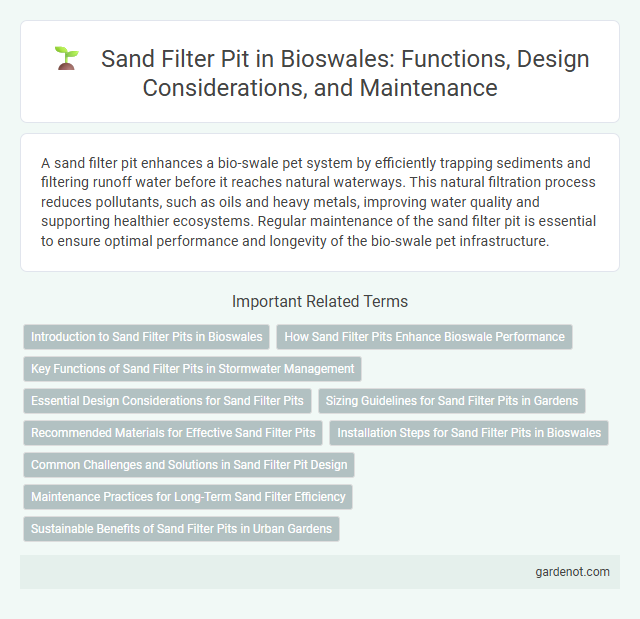A sand filter pit enhances a bio-swale pet system by efficiently trapping sediments and filtering runoff water before it reaches natural waterways. This natural filtration process reduces pollutants, such as oils and heavy metals, improving water quality and supporting healthier ecosystems. Regular maintenance of the sand filter pit is essential to ensure optimal performance and longevity of the bio-swale pet infrastructure.
Introduction to Sand Filter Pits in Bioswales
Sand filter pits in bioswales serve as crucial components for enhancing stormwater management by removing sediments, pollutants, and particulate matter through filtration. These pits consist of engineered layers of sand and gravel designed to capture contaminants before water infiltrates into the surrounding soil or groundwater. Optimized for permeability and pollutant retention, sand filter pits significantly improve water quality while supporting the ecological function of bioswales.
How Sand Filter Pits Enhance Bioswale Performance
Sand filter pits improve bioswale performance by effectively removing suspended solids and pollutants from stormwater through mechanical filtration and microbial interactions within the sand media. These pits enhance infiltration rates, reduce surface runoff, and promote groundwater recharge while maintaining the bioswale's aesthetic and ecological benefits. Incorporating sand filter pits helps meet regulatory standards for water quality and supports sustainable urban stormwater management.
Key Functions of Sand Filter Pits in Stormwater Management
Sand filter pits play a crucial role in stormwater management by effectively removing suspended solids and pollutants through filtration and sedimentation processes. These pits enhance water quality by capturing contaminants such as heavy metals, nutrients, and hydrocarbons before stormwater infiltrates into groundwater or discharges into surface water bodies. Their design supports sustainable urban drainage systems by reducing runoff volume, mitigating erosion, and promoting groundwater recharge.
Essential Design Considerations for Sand Filter Pits
Sand filter pits require precise design considerations including appropriate grain size composition between 0.25 to 0.5 mm to ensure effective filtration and adequate permeability. The pit depth typically ranges from 0.5 to 1 meter to maximize contaminant removal while preventing clogging and promoting proper infiltration rates. Proper grading and underdrain systems are critical to maintaining structural integrity and efficient hydraulic performance in bio-swale applications.
Sizing Guidelines for Sand Filter Pits in Gardens
Sand filter pits in gardens should be sized based on the infiltration rate of the surrounding soil, typically requiring a surface area between 10 to 20 square feet for effective filtration. The depth of the pit is generally recommended to be at least 18 to 24 inches, filled with graded sand to maximize pollutant removal and water percolation. Proper sizing ensures optimal stormwater management, reduces runoff, and enhances groundwater recharge in bio-swale systems.
Recommended Materials for Effective Sand Filter Pits
Effective sand filter pits require high-quality, well-graded sand with particle sizes ranging from 0.25 to 1.0 mm to maximize filtration efficiency and prevent clogging. Incorporating layers of gravel and coarse sand beneath the fine sand layer enhances drainage and supports microbial activity essential for pollutant removal. Using clean, non-toxic, and durable materials like washed river sand and crushed stone ensures long-term performance and maintenance of bio-swale water treatment systems.
Installation Steps for Sand Filter Pits in Bioswales
Installing sand filter pits in bioswales involves excavating a designated area to the specified dimensions, ensuring proper slope for water flow management. The pit is lined with geotextile fabric to prevent soil infiltration, followed by layering of coarse sand and gravel to create effective filtration media. Proper compaction and grading are critical to maintain structural integrity and optimize pollutant removal efficiency in stormwater treatment.
Common Challenges and Solutions in Sand Filter Pit Design
Sand filter pits commonly face challenges such as clogging due to fine sediment accumulation and uneven flow distribution that reduces filtration efficiency. Solutions include incorporating pre-treatment measures like sediment traps to capture larger particles and designing uniform inlet and outlet structures to ensure consistent water flow across the filter media. Regular maintenance protocols and the use of graded sand layers enhance permeability and prolong the operational lifespan of the bio-swale system.
Maintenance Practices for Long-Term Sand Filter Efficiency
Regular inspection and removal of accumulated debris and sediments are essential for maintaining sand filter pit efficiency in bio-swales. Periodic replacement or rejuvenation of the sand media prevents clogging and ensures optimal filtration performance. Proper maintenance extends the lifespan of the sand filter pit, enhancing stormwater treatment and runoff quality in sustainable urban drainage systems.
Sustainable Benefits of Sand Filter Pits in Urban Gardens
Sand filter pits enhance urban gardens by efficiently treating stormwater runoff, reducing pollutants such as oils, heavy metals, and sediments before infiltration. Their permeable sand media promotes groundwater recharge while preventing soil erosion and surface flooding. Integrating sand filter pits supports sustainable water management and improves urban biodiversity by maintaining healthier soil and plant systems.
Sand filter pit Infographic

 gardenot.com
gardenot.com